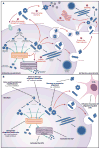α-Synuclein oligomers and clinical implications for Parkinson disease
- PMID: 23225525
- PMCID: PMC3608838
- DOI: 10.1002/ana.23746
α-Synuclein oligomers and clinical implications for Parkinson disease
Abstract
Protein aggregation within the central nervous system has been recognized as a defining feature of neurodegenerative diseases since the early 20th century. Since that time, there has been a growing list of neurodegenerative disorders, including Parkinson disease, which are characterized by inclusions of specific pathogenic proteins. This has led to the long-held dogma that these characteristic protein inclusions, which are composed of large insoluble fibrillar protein aggregates and visible by light microscopy, are responsible for cell death in these diseases. However, the correlation between protein inclusion formation and cytotoxicity is inconsistent, suggesting that another form of the pathogenic proteins may be contributing to neurodegeneration. There is emerging evidence implicating soluble oligomers, smaller protein aggregates not detectable by conventional microscopy, as potential culprits in the pathogenesis of neurodegenerative diseases. The protein α-synuclein is well recognized to contribute to the pathogenesis of Parkinson disease and is the major component of Lewy bodies and Lewy neurites. However, α-synuclein also forms oligomeric species, with certain conformations being toxic to cells. The mechanisms by which these α-synuclein oligomers cause cell death are being actively investigated, as they may provide new strategies for diagnosis and treatment of Parkinson disease and related disorders. Here we review the possible role of α-synuclein oligomers in cell death in Parkinson disease and discuss the potential clinical implications.
Copyright © 2012 American Neurological Association.
Figures

References
-
- Lewy F. Paralysis agitans. In: Lewandowski M, editor. Handbuch der Neurologie. Berlin: Springer; 1912. pp. 920–933.
-
- Jakes R, Spillantini MG, Goedert M. Identification of two distinct synucleins from human brain. FEBS Lett. 1994;345:27–32. - PubMed
-
- Chandra S, Gallardo G, Fernandez-Chacon R, et al. Alpha-synuclein cooperates with CSPalpha in preventing neurodegeneration. Cell. 2005;123:383–396. - PubMed
Publication types
MeSH terms
Substances
Grants and funding
LinkOut - more resources
Full Text Sources
Other Literature Sources
Medical
Miscellaneous

